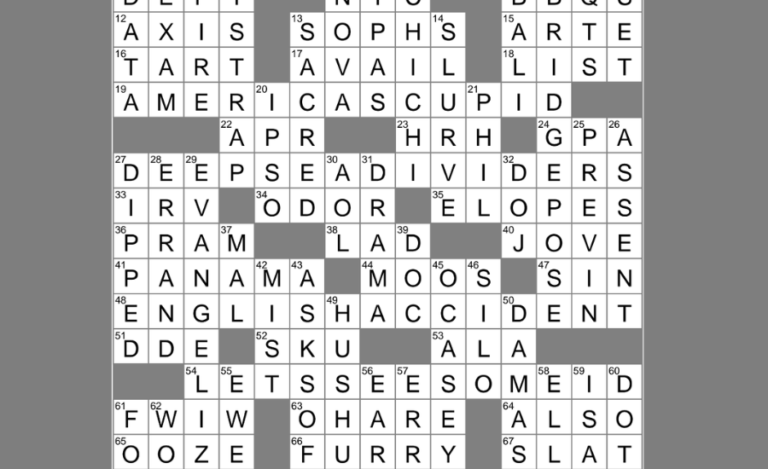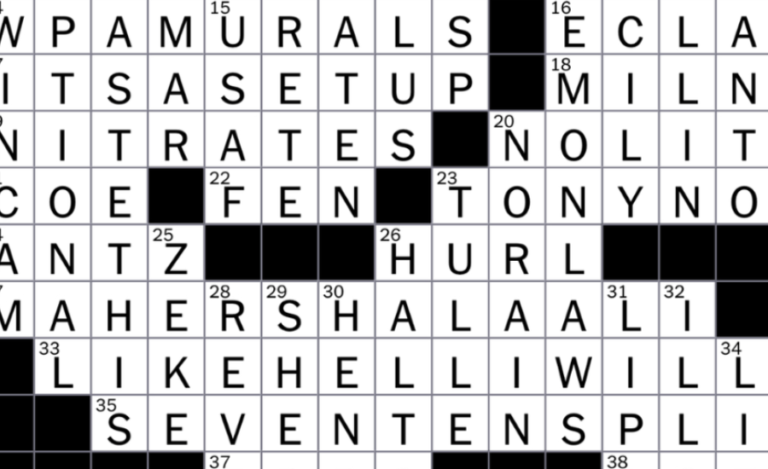Arousing Suspicion NYT Crossword Clue & Possible Answers
Feeling stuck on the crossword puzzle, particularly with the clue “Arousing Suspicion” from The New York Times? You’re not alone. This challenging phrase often leaves even the most experienced solvers pondering their next move. The New York Times crossword is celebrated for its witty and elusive clues, and this one is a prime example of that cleverness. Whether you tackle crosswords daily or just enjoy them occasionally for a mental challenge, deciphering the meaning of “arousing suspicion” can unlock various possibilities and help you fill in that elusive blank on your grid. Let’s delve into the nuances of this intriguing clue and discover the strategies to crack it wide open!
Understanding The Clue: Arousing Suspicion NYT

The phrase “arousing suspicion” in crossword puzzles often alludes to something that provokes doubt or raises questions. To solve this clue effectively, it’s essential to explore synonyms and related terms that convey a sense of uncertainty or curiosity. Consider words such as “doubtful,” “suspicious,” or “questionable” as possible answers.
Crossword constructors are known for their creative play with language, so the answer might not be a straightforward term. It could be a less obvious word or phrase that encapsulates the concept of suspicion in a subtle or indirect way.
Approaching this clue requires a blend of creativity and lateral thinking. Pay attention to double meanings or idiomatic expressions that capture the essence of suspicion. Remember, every word in the clue holds significance, and often, the answer is cleverly hidden within the nuances of language. Stay vigilant for those clever twists that can lead to the solution.
Possible Answers to the Arousing Suspicion NYT Crossword Puzzle
When tackling the “Arousing Suspicion” clue in the New York Times crossword puzzle, several potential answers could fit the bill.
One common solution is “SUSPECT,” which encapsulates the concept of doubt and uncertainty effectively. It directly aligns with the theme of suspicion, making it a strong candidate.
Another possible answer is “QUERY.” This term suggests an element of questioning, which dovetails neatly with the notion of suspicion.
The word “DOUBT” also comes into play as a fitting choice. It’s a direct expression of the uncertainty and skepticism that often accompany suspicion.
Alternatively, consider words like “EERIE” or “UNSETTLING.” Both of these options evoke a sense of unease and discomfort, which can be associated with suspicion.
Each of these answers provides a different perspective on the theme of suspicion, offering multiple avenues for crossword solvers to explore. Whether you choose a straightforward term like “DOUBT” or a more nuanced option like “EERIE,” each answer adds a unique flavor to the overall puzzle.
Tips And Strategies For Solving The Clue

- When approaching the “arousing suspicion” clue in the New York Times crossword puzzle, it’s crucial to start by analyzing the context provided by the clue. Begin by brainstorming synonyms and phrases that convey a sense of doubt, intrigue, or unease, as these are likely to lead you toward the correct answer.
- Next, pay close attention to the word count specified in the clue. This detail often indicates the number of letters in the answer, which can significantly narrow down your options and help you identify potential solutions.
- Utilize any letters you already know from intersecting clues to your advantage. Filling in these known letters can provide valuable hints and help you piece together a word that fits both the meaning and the crossword’s grid structure.
- Think creatively and consider lateral approaches. Sometimes, the solution may come from a less conventional angle, rather than sticking strictly to traditional definitions or synonyms.
- If you find yourself stuck, don’t be afraid to take a break. Stepping away for a short period can offer a fresh perspective and lead to those ‘aha!’ moments where the answer suddenly becomes clear. This approach can often help you see connections or patterns that were previously elusive.
FAQs
Q: What should I consider first when solving the “arousing suspicion” NYT crossword clue?
A: When tackling the “arousing suspicion” clue, begin by examining the context provided. Reflect on synonyms and phrases associated with suspicion, such as those that imply doubt, unease, or curiosity. This initial step helps set the direction for finding an answer that aligns with the clue’s theme and tone.
Q: How does the word count in the clue assist in solving it?
A: The word count specified in the clue is a critical detail as it indicates the number of letters in the solution. This information helps narrow down potential answers by matching them to the puzzle’s format and constraints, ensuring that your choices fit the available spaces in the grid.
Q: How can intersecting clues be helpful when solving the “arousing suspicion” clue?
A: Intersecting clues can be immensely helpful as they provide known letters that you can use to deduce the solution. By filling in these letters, you can narrow down possible answers and better match them to both the clue’s meaning and the puzzle’s layout. This approach leverages the puzzle’s structure to guide you toward the correct answer.
Q: What does it mean to think laterally when solving a crossword clue?
A: Thinking laterally involves adopting a creative approach to solving clues, rather than relying solely on direct definitions. It means exploring unconventional interpretations, related concepts, or indirect associations that could lead to the right answer. This method often uncovers solutions that are not immediately obvious.
Q: Why is taking breaks beneficial when working on a crossword clue?
A: Taking breaks can be highly beneficial as it allows you to return to the puzzle with a refreshed perspective. Stepping away momentarily often leads to new insights and helps clear mental blocks, making it easier to see connections or patterns that might have been missed before. This technique can lead to those crucial ‘aha!’ moments when you resume solving.
Conclusion
Successfully cracking the “arousing suspicion” clue in The New York Times crossword puzzle demands a combination of strategic thinking and imaginative problem-solving skills. Start by carefully considering the context of the clue, as understanding its nuances will guide you toward the right answer. Utilize the word count provided to narrow down potential solutions, ensuring that your answer fits both the clue’s theme and the puzzle’s format. Intersecting clues are invaluable, as they offer critical letters that help shape your answer and fit it seamlessly into the puzzle. Embrace lateral thinking by exploring unconventional interpretations and related concepts, as this creative approach can often lead to breakthroughs. Additionally, don’t underestimate the power of taking breaks; stepping away from the puzzle can refresh your mind and provide new insights when you return. By applying these strategies, you’ll enhance your ability to tackle challenging crossword clues and turn complex puzzles into rewarding accomplishments.
Keep up with the latest news and alerts by visiting us online: NY-Tribune!




